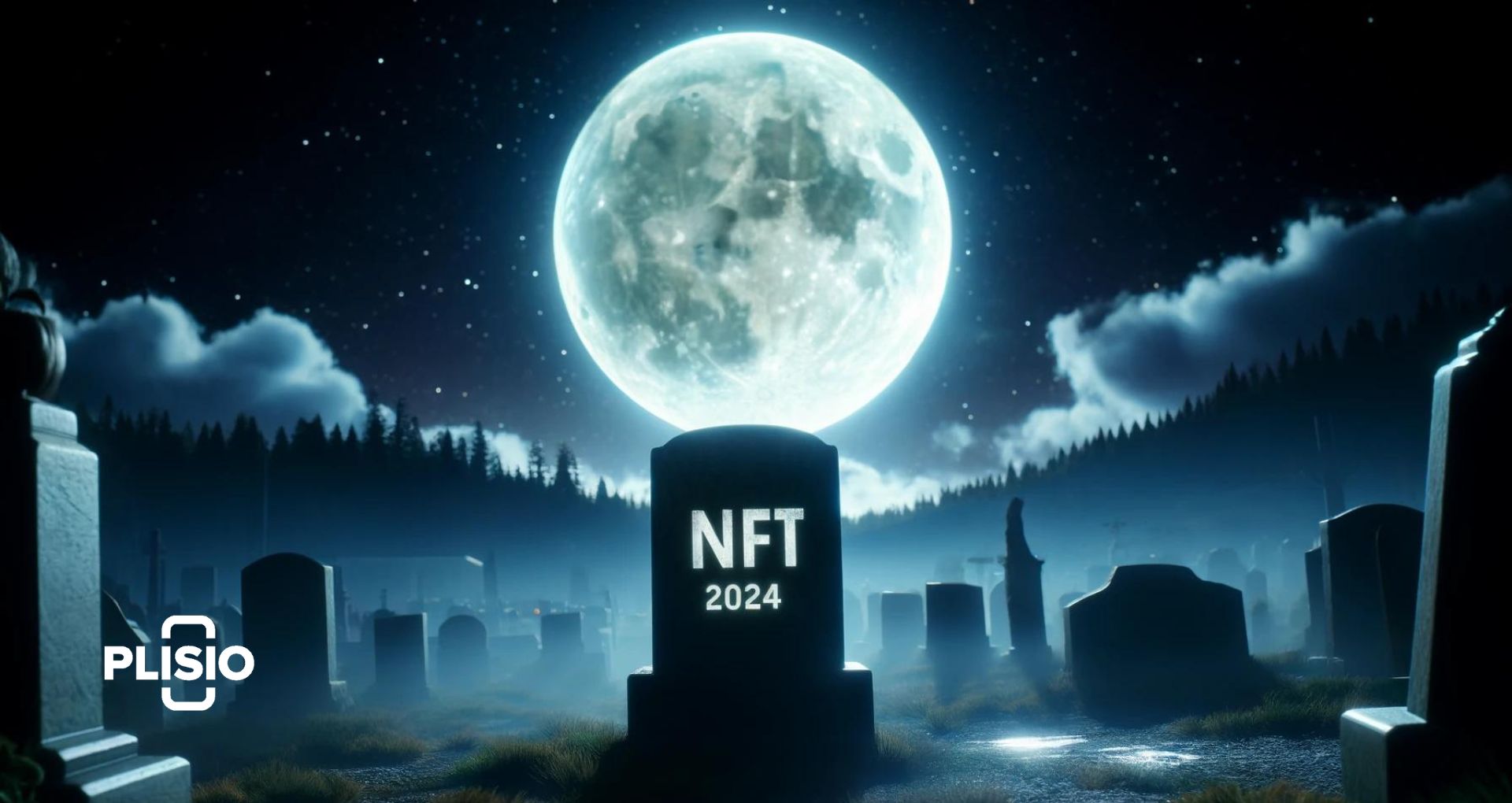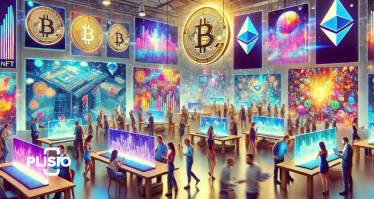Are NFTs Dead?

Non-fungible tokens (NFTs) burst onto the scene around 2021, capturing the imaginations of investors, artists, and tech enthusiasts alike. These digital certificates of ownership, often tied to unique pieces of digital art, quickly became the talk of the tech world. In 2021, the total value of NFTs traded reached $17.6 million and skyrocketed to $24.7 billion in 2022, marking a period of explosive growth and widespread attention. Media outlets and investors were enthralled by the potential of NFTs to revolutionize ownership and digital art.
However, as we moved into 2023, the once vibrant NFT market experienced a significant slump, with its total value dropping to $11.8 billion. The hype around expensive digital collectibles began to wane, overshadowed by the meteoric rise of AI-related technologies. Search volumes for NFTs plummeted by 82%, and the market's value decreased by 90% from its peak in 2021. Despite this downturn, NFTs have not become obsolete. Instead, they are evolving beyond their initial association with digital art, finding new relevance in loyalty programs, special access experiences, and more practical applications. The market is showing signs of maturity, focusing on sustainable value and real-world utility.
NFT Market Collapse in Recent Years
The NFT market, which once experienced an unprecedented surge, has faced a significant downturn in recent years. After reaching a peak trading value of $24.7 billion in 2022, the market saw a dramatic decline, with the total value plummeting to $11.8 billion in 2023. This drop was exacerbated by a series of scandals in the crypto market that eroded investor confidence and led to a perception of NFTs as a fleeting trend. The initial hype, driven by speculative investments in digital art and collectibles, began to wane, leaving many to question the long-term viability of NFTs.
A major factor contributing to this decline was the explosive rise of artificial intelligence (AI) as a dominant technological trend. As AI captured global attention, search volumes for AI-related topics surged by 13,210% in 2023, overshadowing interest in NFTs. Consequently, NFT-related search volumes dropped by 82%, reflecting a shift in public and investor focus. Despite these challenges, the NFT market is not entirely in ruins. While its speculative bubble may have burst, the underlying technology still holds potential for applications in various sectors, such as loyalty programs and digital ownership verification, indicating a possible path to recovery and sustained relevance.
Expanding NFTs
Brands are increasingly exploring innovative ways to incorporate NFTs into their loyalty programs and special experiences, leveraging the unique properties of blockchain technology to enhance customer engagement. Unlike the early days of speculative digital art sales, today's NFTs are being used to give consumers ownership of exclusive content, access to special events, and rewards for brand advocacy. This shift reflects a broader understanding of NFTs as versatile tools rather than mere digital collectibles. For instance, NFTs can now offer consumers a sense of belonging and participation in a brand's ecosystem, extending beyond mere transactions to foster deeper connections.
Several brands have successfully implemented NFT strategies to great effect. For example, Coca-Cola and Nike have used NFTs to create unique customer experiences that blend the physical and digital worlds. Coca-Cola's NFT initiatives have included limited-edition digital collectibles that offer exclusive perks, while Nike's NFT offerings have allowed customers to own virtual sneakers that can be worn in digital environments. Another notable example is the Pudgy Penguins collection, which has expanded its reach by partnering with major retailers like Walmart and Target to sell physical products tied to their NFTs. These strategies not only enhance customer loyalty but also provide new revenue streams and innovative ways for brands to interact with their audiences.
Mature Signs of the Market
The evolution of the NFT market shows clear signs of maturity, moving beyond its initial phase of speculative frenzy to a more stable and sustainable model. As the market matures, NFTs are increasingly being integrated into broader economic and social frameworks, emphasizing ownership verification and long-term value over short-term gains. This shift is evident in the way top companies like Coca-Cola, Nike, and Gucci have adopted NFTs to enhance customer engagement and brand loyalty. By seamlessly incorporating NFTs into their strategies, these brands offer customers unique experiences that bridge the gap between the physical and digital worlds, fostering deeper connections and long-term loyalty.
NFTs play a crucial role in enhancing customer engagement by offering personalized and exclusive content, creating a sense of ownership and participation. For instance, brands use NFTs to grant special access to events, limited-edition products, and unique digital experiences, all of which incentivize customers to remain engaged and loyal. This strategy not only strengthens the bond between the brand and its customers but also opens up new avenues for interaction and value creation. As a result, NFTs have become an indispensable tool in the digital economy, driving customer engagement and fostering lasting brand loyalty in a way that traditional methods cannot match.
NFT’s Future: Describing the Transformation
Market reports indicate that the NFT sector is poised for significant transformation, moving towards a more diversified and sustainable future. Leading NFT market tracking platforms such as CryptoSlam, nonfungible, and DappRadar predict that 2024 will witness substantial changes, with a marked increase in the number of creators, artists, and derivative products entering the space. This influx of new participants suggests a shift from a market driven by speculation to one focused on creativity and utility. The expanding ecosystem is expected to bring fresh perspectives and innovative applications, further embedding NFTs into various industries beyond digital art.
As more creators and artists embrace NFTs, we can anticipate a broader range of derivative products that cater to diverse interests and needs. This growth is not just about increasing the volume of NFTs but also enhancing their quality and utility. For example, NFTs are increasingly being used in areas such as gaming, music, and virtual worlds, offering new ways for fans to interact with their favorite content and creators. This evolution reflects a more mature market that values sustainability and real-world applications over mere hype. The continued development of the NFT sector promises to unlock new opportunities for innovation and engagement, solidifying NFTs' place in the digital economy.
Don’t Call It NFT
In recent times, the term "NFT" has developed a stigma, largely due to its early association with speculative digital art sales that led many to view them as overpriced and volatile assets. This negative perception has prompted brands to avoid using the term "NFT" in their marketing and customer interactions. Instead, they focus on the practical applications and benefits of the underlying blockchain technology. For instance, Lin Dai, CEO of the Web3 company and NFT platform OneOf, compared the situation to Fight Club, stating, "The number one rule of working on NFT and Web3 technology for enterprise companies is you don’t use the word NFT". This strategy helps brands circumvent the baggage associated with NFTs while still leveraging their capabilities.
Beyond digital art, NFTs have found numerous practical applications that enhance their value and utility. Brands are using NFTs to modernize traditional loyalty programs, offering customers unique digital certificates that provide access to exclusive content, events, and rewards. For example, OneOf has partnered with companies like Mastercard and Snapple to connect millions of consumers through innovative loyalty programs. Additionally, NFTs are being used to ensure transparency and traceability in supply chains, allowing consumers to verify the origins and authenticity of products. This practical application of NFTs extends their relevance far beyond digital art, embedding them into everyday transactions and experiences, and demonstrating their potential to revolutionize various aspects of the digital economy.
The NFT Market Adjusts to Be Different
The NFT market is steadily repositioning itself as a viable long-term investment, moving away from the speculative bubble that characterized its early days. This shift is evidenced by a growing focus on the intrinsic value and practical applications of NFTs rather than just their novelty. As the market matures, investors are increasingly viewing NFTs as digital certificates of ownership that can be used in a variety of contexts, from real estate to digital collectibles. This new perspective is helping to stabilize the market, making it less susceptible to the dramatic price swings and speculative frenzy that previously defined it.
A key factor in this stabilization is the balance between buyers and sellers. Market data shows a trend towards equilibrium, with the number of active buyers and sellers becoming more balanced. This balance is crucial for market stability, as it prevents the extreme volatility caused by sudden influxes or exits of participants. A stable market with consistent demand and supply allows for more predictable and sustainable growth. Blue-chip NFTs, which represent high-quality and valuable assets, continue to hold sway, further underpinning the market's resilience. As the market adjusts to these new dynamics, it is poised to become a cornerstone of the digital economy, offering reliable and enduring value to investors.
A Hopeful Future for the NFT Market in 2024 and Beyond
The future of the NFT market in 2024 and beyond looks promising as NFTs continue to gain popularity and maintain their value through innovative applications and strategic integrations. As the technology matures, its potential to revolutionize various industries becomes more apparent. Brands and creators are leveraging NFTs not just as digital art pieces but as tools for enhancing customer engagement, loyalty programs, and ownership verification. This broader application is helping to solidify the place of NFTs in the digital economy, ensuring their continued relevance and value.
Examples of successful NFT projects highlight the diverse ways in which NFTs are being used to create value. Pudgy Penguins, for instance, has expanded its reach by partnering with major retailers like Walmart and Target to sell physical products tied to their NFTs, effectively bridging the gap between digital and physical markets. Similarly, CryptoPunks, one of the first major NFT collections, has maintained its value due to its historical significance and rarity. These projects demonstrate how NFTs can be effectively integrated into broader business strategies, offering unique experiences and tangible benefits to consumers. As more brands adopt similar approaches, the NFT market is likely to see sustained growth and innovation, paving the way for a vibrant and dynamic future.
Conclusion
In conclusion, the NFT market has undergone significant transformation, evolving from a speculative frenzy into a more mature and sustainable sector. Despite the initial hype and subsequent decline in value and interest, NFTs have proven their resilience and potential for long-term growth. Key indicators of market maturity include the balanced dynamics between buyers and sellers, the adoption of NFTs by major brands for loyalty programs and customer engagement, and the shift towards practical applications beyond digital art. These developments suggest that NFTs are not only surviving but also adapting and thriving in a rapidly changing digital landscape.
Looking ahead, the future of NFTs appears bright, with numerous opportunities for innovation and expansion across various industries. From real estate and supply chain management to entertainment and gaming, NFTs offer unique solutions for ownership verification, transparency, and customer interaction. As technology continues to evolve, so too will the applications and utility of NFTs, embedding them further into our daily lives. The integration of NFTs into broader economic and social frameworks will likely drive their continued relevance and value, making them an indispensable tool in the digital economy. The journey of NFTs is far from over, and their potential to revolutionize multiple sectors remains vast and promising.




